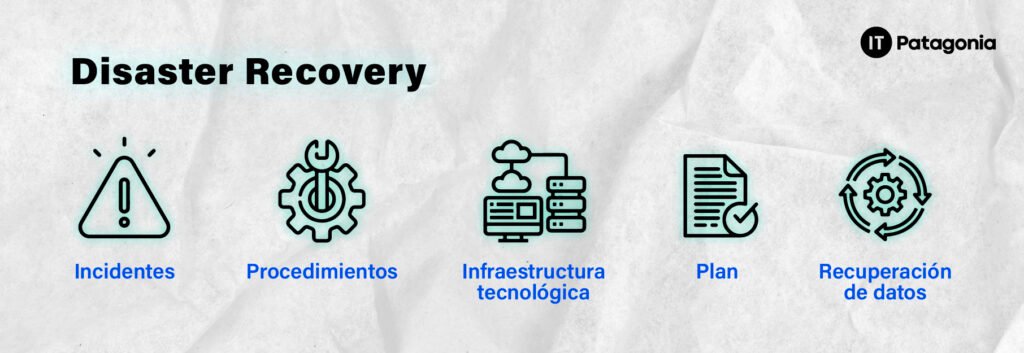Disaster recovery: how to always be prepared
We live in a context of exponential growth in data and transactions managed by organizations and individuals, driven by digital transformation. In this context, the importance of having a disaster recovery plan is magnified.
Why? A disaster recovery plan is critical to ensuring business continuity, protecting your infrastructure, systems and data, and maintaining customer trust.
Also, to meet service expectations and ensure competitiveness in a digital environment where any downtime can translate into substantial economic and reputational losses.
In the course of this article we analyze the Key indicators to consider in a disaster recovery plan and its essential components.
We also address the importance of having a disaster recovery strategy and describe the steps required to put together a disaster recovery plan.
What is a disaster recovery plan?
The disaster recovery plan is a detailed set of procedures and strategies designed to help an organization Quickly recover from disruptive events that may affect your IT infrastructure, your data, and your critical operations.
Includes:
- the identification of risks and threats,
- the definition of recovery objectives such as RTO and RPO,
- data backup and replication strategies, and
- specific procedures for communication, role assignment, and execution of recovery tasks.
Its main objective is Minimize downtime and data loss, and ensure the operational continuity of the business.
It also seeks to protect the assets and reputation of organizations against a natural disaster, a hardware failure, or a cyber attack, among other events.
Sectors with greater awareness of the importance of the disaster recovery plan
By identifying the sectors with the greatest awareness of the importance of disaster recovery processes, we can highlight:
- financial services
- health area
- IT industry
- telecommunications companies
- government entities
- public services
- e-commerce and retail
- manufacturing industry
- universities and research centers
- the media and entertainment
- aerospace and defense sector
All of them not only have a high awareness of the importance of disaster recovery processes, but are also often subject to Strict regulations and compliance standards that require the implementation of robust and regularly tested plans.
What situations does a Disaster Recovery plan protect against?
A disaster recovery plan is designed to protect an organization against a variety of situations that may disrupt its operations.
Among them:
- Natural disasters: earthquakes, floods, hurricanes and storms, and fires.
- Infrastructure problems: power outages, hardware failures and network disruptions.
- Cyberattacks: ransomware, malware, phishing and identity theft.
- Human errors: accidental deletion of data or incorrect settings.
- Software problems: failed updates, bugs and application errors.
- Internal security issues: when current or former employees intentionally compromise data or systems or access systems or data without permission.
- Environmental and health disasters: pandemics or situations of chemical or biological contamination.

Key indicators to consider in a disaster recovery plan
Key indicators to be considered in a disaster recovery plan are: Essential metrics that help evaluate your effectiveness and efficiency and enable the organization to continually measure and improve its disaster response capabilities.
Recovery Time Objective (RTO)
It stipulates the maximum tolerable time that a system, application or function can be out of service after a disaster before the operation and business are negatively affected.
In other words, the RTO establishes the The period of time within which a system must be operational again after a disaster to minimize the impact on the organization.
This objective influences recovery strategies and resource prioritization during a crisis to ensure critical processes are restored quickly to maintain business continuity.
Recovery Point Objective (RPO)
Defines the maximum amount of data that can be lost in the event of a disaster, measured in terms of time. Additionally, set the time limit from the last acceptable backup or recovery point before an incident occurs.
This objective determines how frequently data should be backed up, to ensure that information loss remains within a tolerable margin for business operations.
A short RPO means more frequent backups and less data loss, while a longer RPO may be appropriate for less critical systems.
Downtime
It refers to the period during which an organization's systems, applications or services are not operational due to an interruption, whether due to technical failures, natural disasters, cyberattacks or other disruptive events.
This time includes both the duration of the initial outage and the time required to fully restore normal operations.
Downtime is a critical indicator because it can have significant consequences, including loss of revenue, negative impact on reputation, decreased productivity and possible regulatory penalties.
Therefore, minimizing downtime is an essential priority in any disaster recovery plan.
Recovery Consistency Objective (RCO)
The disaster recovery consistency objective refers to the goal set to ensure that data and systems restored after an incident are coherent and consistent with the most recent state before the disaster.
Seeks to ensure that the critical information and business processes are recovered accurately and completely, without significant data loss or discrepancies that could affect operational integrity.
To achieve this, it is crucial to properly synchronize and manage backups, replicate data consistently during recovery, and apply recovery strategies that minimize any inconsistencies or deviations between the original and restored systems.
Complying with the RCO is essential for Maintain business continuity and customer confidence, and ensure that operations can resume with minimal disruption following a catastrophic event.

5 essential components of a disaster recovery plan
The following elements of a disaster recovery plan help ensure that an organization can minimize the impact of a disaster and resume operations as quickly and efficiently as possible.
Backup
In the context of disaster recovery, a backup is a duplication of important data and files that is stored in a secure location separate from the main system to protect the information from loss, damage or corruption.
Backups are performed regularly to ensure that data can be restored to a previous point in time in the event of a disaster, such as hardware failure, cyberattacks, human error, or natural disasters.
This practice is critical for business resilience and continuity., enabling operations to resume with minimal data loss and downtime following a disruptive incident.
Regular testing
These are exercises planned and executed periodically to evaluate and verify the effectiveness of a disaster recovery plan (DRP).
They imply Simulate disaster scenarios to ensure that all procedures and strategies outlined in the DRP are working correctly and that critical systems and data can be recovered within the time frames established by the recovery objectives (RTO and RPO).
Regular testing helps identify flaws and areas for improvement, ensure staff are familiar with their roles and responsibilities during a crisis, and keep the plan up to date in the face of changes in infrastructure, technology, or emerging threats.
Redundant systems
These are duplicate configurations of critical infrastructure, applications, or data that are designed to ensure availability and business continuity in the event of a failure or disruption.
These redundant systems can include servers, data storage, networks, and other key components, which are replicated across multiple physical locations or in the cloud.
The idea behind redundancy is to provide a additional layer of resilience, which enables critical operations to be maintained without significant interruptions, even if a portion of the main system experiences problems.
This ensures that in the event of a disaster, the organization can quickly switch to redundant systems to maintain operational continuity and minimize the impact on services and end users.

risk assessment
Continuous analysis of potential risks and their impact on the organization, along with strategies to mitigate them.
It is a systematic and structured process designed to identify, analyze and evaluate potential threats that could affect the availability, integrity and confidentiality of an organization's information systems and critical operations.
This assessment seeks determine the probability of occurrence of different types of disasters and the potential impact of these events on business operations.
The results of the risk assessment allow the organization to prioritize resources and develop appropriate mitigation strategies, including:
- the implementation of preventive and corrective measures,
- business continuity planning, and
- the development of a robust and effective disaster recovery plan.
Communication protocols
Established procedures and guidelines for facilitate effective and efficient communication during and after a disruptive incident.
These protocols are designed to ensure that all stakeholders, including the recovery team, employees, customers, suppliers and other relevant external parties, are adequately notified of the emergency situation.
This may include the use of specific communication channels, the definition of roles and responsibilities in the transmission of critical information, and the implementation of early warning systems for rapid response.
Effective communication protocols ensure that coordination is smooth, confusion is minimized, and transparency is maintained throughout the recovery process.
The objective: to contribute to the Reduced downtime and rapid restoration of operations.
Why is a disaster recovery plan important?
A disaster recovery plan is crucial because it ensures business continuity in the event of catastrophic events that may disrupt an organization’s operations.
Some of the main reasons that justify the construction and execution of a disaster recovery plan are:
- Provides a structured framework for fast and efficient recovery of critical systems and data.
- Minimizes downtime and allows the company to resume operations as soon as possible.
- It enables compliance with regulations and expectations of customers and business partners.
- Ensure compliance with strict regulations, which require the implementation of disaster recovery measures to protect data and critical infrastructure.
Without a proper plan, an organization may face significant losses in terms of data, revenue and reputation.
A well-designed disaster recovery plan demonstrates the company's commitment to security and resilience, building trust among customers and strengthening business relationships.
What needs do disaster recovery processes cover?
Implementing disaster recovery processes covers various critical needs for organizations.
It focuses on ensuring the continuity of operations and business in the face of adverse events, from various angles.
1. Data protection: Ensures that critical information is backed up and can be recovered, with minimal loss. It also ensures that data is accurate and available when needed, even after a disaster.
2. Minimizing downtime: allows the company to continue maintaining its essential operations during and after a disruptive event.
3. Compliance with current regulations, rules and standards that require data protection and recovery plans (such as GDPR, HIPAA, etc.).
4. Financial protection: Mitigates the economic impact of business interruption, including lost revenue and costs associated with disaster recovery.
5. Maintaining customer trust, assuring them that their data and services will be available and secure, even in emergency situations.
6. Protecting the company's reputation by demonstrating disaster preparedness and resilience.
7. Identifying potential threats and development of strategies to mitigate them and respond proactively to security incidents and other risks.
8. Efficient system and data recovery, by planning and preparing a structured and tested framework to achieve this.

11 steps to create a disaster recovery plan (DRP)
Creating a disaster recovery plan involves several detailed and structured steps that ensure an organization can quickly recover from disruptive events.
1. Business Impact Analysis (BIA)
It consists of identifying those processes and functions that are essential for the continued operation of the business. From there, the consequences of their interruption are evaluated in terms of finances, reputation and operation.
2. risk assessment
It involves listing possible threats such as natural disasters, technological failures, cyber attacks, human errors, etc. Likewise, analyzing the vulnerability of the infrastructure or its systems.
3. Setting recovery objectives
This includes setting the maximum tolerable time that a system can be down (Recovery Time Objective, RTO), and the maximum amount of data that can be lost in the event of a disaster, measured in terms of time (Recovery Point Objective, RPO).
4. Development of recovery strategies
Establish a regular and secure backup system, configure data replication, and prepare secondary recovery sites.
5. Creating a communication plan
Define emergency notifications and ensure that alternative communication channels exist if primary ones are not available.
6. Assignment of roles and responsibilities
Designate a specific team responsible for implementing the disaster recovery plan, and assign clear tasks to each member during the recovery process.
7. Development of recovery procedures
Document detailed instructions on how to restore systems, data, and applications, and define priorities for restoring critical services.
8. Regular tests and simulations
Conduct periodic testing of the plan to identify flaws and areas for improvement, and conduct realistic simulations to prepare staff and validate the effectiveness of the plan.
9. Continuing education
Training and raising awareness of staff on DRP procedures and emergency response. In parallel, conduct drills to ensure that everyone knows how to act during a disaster.
10. Documentation and accessibility
Ensure that all DRP-related documentation is complete, up-to-date, and easily accessible.
11. Continuous monitoring and support
Provide 24×7 technical support that constantly monitors systems to quickly detect and respond to problems and is prepared to respond to incidents and assist in recovery.
Conclusion
Developing and implementing a disaster recovery plan presents several challenges for an organization.
Among the main ones, we can mention
- the identification and prioritization of critical assets,
- the complexity of coordinating different departments and systems, and
- the need for adequate technical and financial resources.
Additionally, organizations must ensure that the plan is kept up to date with technological and operational changes, and ensure ongoing training of staff to execute the plan effectively.
Another important challenge is to periodically test the plan to identify and correct potential failures, as well as ensure compliance with industry regulations and standards.
All of this requires a strategic approach and ongoing commitment to effectively manage and mitigate risks.
Due to the complexity and indispensability of this work, disaster recovery service (DraaS) is becoming increasingly popular among organizations.
This importance is explained by the wide range of advantages that come with being able to take advantage of the knowledge of a supplier specialized in this type of projects. Contact us to find out how we can help you. help you secure your organization in the event of an incident.

